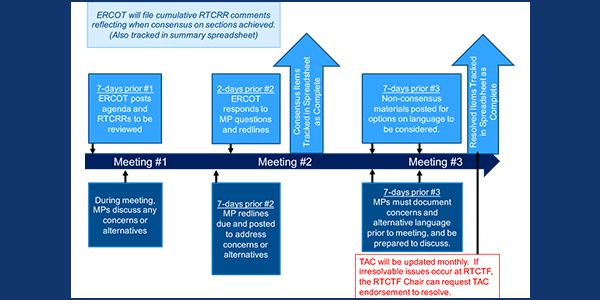By Tom Kleckner
ERCOT stakeholders have begun the arduous process of reviewing and commenting on the protocol changes the grid operator has drafted to add real-time co-optimization (RTC) to its energy-only market.
Members of the Real-Time Co-optimization Task Force and other interested stakeholders began walking through staff’s initial set of protocol revision requests during a conference call Wednesday. The goal is to reach consensus and secure the changes’ approval before the year is out.
The task is not without consequence for staff and stakeholders.
Staff have drafted seven Nodal Protocol revision requests (NPRRs) and two other changes, using language the RTCTF developed last year as a starting point. The task force’s key principles were approved by ERCOT’s Board of Directors in February. (See “Real-Time Co-optimization Team Finalizes Scope,” ERCOT Board of Directors Briefs: Feb. 11, 2020.)
The revisions take up 549 pages, 248 alone for NPRR1010. The changes align the language related to the adjustment period (for trades, self-schedules and resource commitments) and real-time operations with the upcoming RTC terminology and operating environment.
“That’ll be the pain point,” predicted ERCOT’s Matt Mereness, the task force’s chair.
During the call, stakeholders debated the more efficient methods of reviewing the language. Some called for going NPRR by NPRR, but others agreed with staff’s recommendation to review the NPRRs by areas of common processes.
“To me, we would be a whole lot better off if we took [individual NPRRs] … and go through the whole darn thing top to bottom,” consultant Floyd Trefny said. “The problem is when you break it up in all these pieces and try to put it back together again, it seems like it’s going to fall apart. That’s what concerns me.”
Mereness responded by saying it would be “embarrassing” to say how many hours staff spent on devising the review process. ERCOT’s approach, he said, would place the right subject-matter experts in the same room at the same time.
“We’re seeing the efficiencies of the stakeholders having the right people in the room,” Mereness said.
Comments Encouraged
Staff said they welcomed formal comments through the revision request process. They also encouraged market participants to send red-lined revisions to the task force for its consideration.
ERCOT has scheduled nine meetings for the group to finalize the revisions, culminating in a number of Technical Advisory Committee subcommittee meetings in October. The TAC would then be given a chance to endorse the NPRRs in November, with the board taking them up in December.
“For the task force’s purposes, anyone at any time has the right to make comments,” Mereness said. “We don’t want to create so much structure that we can’t move forward. TAC will be the place to get unstuck.”
Mereness said ERCOT would “consider” adding changes if they save stakeholders money, but he wouldn’t guarantee changes outside the team’s scope would be accepted.
“We’re laser-beamed in how to get real-time co-optimization in successfully,” Mereness said. “We have to keep that laser-beam focus on getting through those 549 pages. If something is wrong, let us know. We’ve done our best to keep us in a good structural place.”
The delivery schedule remains aligned with upgrades to ERCOT’s Energy Management System, scheduled to go live in May 2024.
ERCOT is projecting it will cost $50 million to $55 million to add the RTC tool, which procures both energy and ancillary services every five minutes, to the market.
The nine revision requests the task force is working on:
- NPRR1007: Updates the protocols for the ERCOT system’s management activities to address changes associated with RTC’s implementation.
- NPRR1008: Updates day-ahead operations’ protocols.
- NPRR1009: Updates transmission security analysis and reliability unit commitment to address RTC’s changes.
- NPRR1010: Updates protocols to account for RTC’s changes to the adjustment period and real-time operations.
- NPRR1011: Updates protocols on performance monitoring.
- NPRR1012: Updates protocols on settlement and billing for RTC’s implementation.
- NPRR1013: Updates the protected information provisions, definitions and acronyms; market participants’ registration and qualification; and market suspension and restart.
- NOGRR211: The Nodal Operating Guide revision request updates language related to supplemental ancillary service markets, ancillary service deployment, and ancillary service responsibilities and obligations.
- OBDRR020: The other binding document revision request updates the methodology for setting maximum shadow prices for network and power balance constraints to address changes associated with RTC’s implementation.





